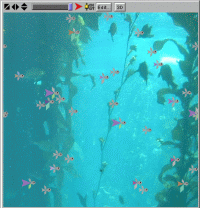When a predator uses color and shape to identify the location of prey in an environment, then the colors and patterns in the environment provide additional selective pressure on the prey. If some prey tend to blend into the background better, these prey tend to survive longer and reproduce more often. If this continues over many generations, the distribution of colors in a population may shift to become more camouflaged with the surrounding environment.
For example, green bugs may emerge as the predominate color in a population of bugs in a forest. Or sandy colored bugs may emerge as the predominate color in a population of bugs on the seashore or in the desert.
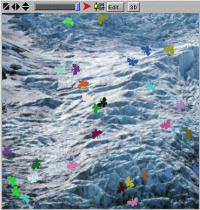
The model captures a very simple mechanism for emergent body structures from three simple NetLogo commands. It shows how increased artificial selection can increase the divergence of the genotype of individuals in a lineage. It also shows the near infinite complexity that results from recombinations of simple instructions.
The
model displays the family
tree for the parent / offspring relationships for different lineages of
individuals you select for reproduction.

This model demonstrates the phenomenon of genetic drift. Turtles of different colors randomly move about the screen; at the end of each timestep, if turtle A is directly one square to the right of turtle B, turtle A's color changes to match that of turtle B. Then, the cycle is repeated. Even though there is no differential fitness between individuals of different colors, the model inevitably converges to a completely homogenous population within an isolated region.. Although which color will end up "winning" is unpredictable, it is a surety that the population will converge to only one color within that region. Try adding walls and removing walls to see what happens to sub-populations as they become isolated and then come back into contact with one another.
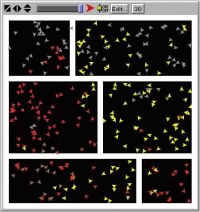
A population of plants is used to show two gene expression patterns. One of these is that of dominant and recessive forms of a gene; the other pattern is that of co-dominant genes.
This population of plants can be allowed to either cross fertilize in the wild using bees to transmit pollen from one plant to another, or the user can artificially cross fertilize or self fertilize some or all the plants. After fertilization, the user can allow the seeds of the plants to grow in the same location or move, organize, and label the seeds to make sense of the outcomes of various fertilization events in the following season of plant growth.
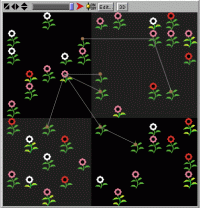
This model simulates the Baldwin Effect, a famous (and largely misunderstood) evolutionary phenomenon. The Baldwin Effect is observed when a new fitness-increasing behaviour is too complicated to initially be coded for genetically; instead, the organisms that survive and reproduce will be those who can learn the behaviour during their lifetimes. There are costs associated with such phenotypic plasticity, however. Therefore, if the same challenge regularly presents itself, future offspring will tend to know much of the behaviour instinctually; that is, their genotype will code for the behaviour directly. The important point is that the phenotypically plastic individuals allowed the species to survive long enough for the behaviour to be "codified" into the species' genotype.

One selective force is that predators that chase prey tend to catch slower moving prey more often, thereby selecting for prey that are faster over many generations of offspring. A competing selective force is that predators who wait for their prey without moving tend to catch prey that are moving faster, thereby selecting for prey that are slower over many generations of offspring.
By adjusting whether bugs try to avoid the predator, the predictability of their motion, and the predator's hunting strategy, the user may coerce either of these competing forces to dominate as the greater selective pressure on the population.
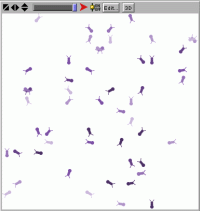
When you run the model you can play the role of a predator or mate as you interact with a population of guppies. As a predator you will probably notice that the more brightly colored a male guppy is, the more likely he will be seen by you, the predator. In this model (as happens in the wild), in streams where predators are plentiful, male guppies become increasingly drab over generations, pushed by predation pressure towards greater camouflage.
You will notice that many guppies are also very colorful and have garish patterns and large tails. This is because to be reproductively successful, guppies have to do more than survive, they also have to reproduce -- and to do that, they have to attract mates. The "flashier" a male guppy is, the more likely a female guppy will choose him as a mate, giving him the opportunity to pass his genes along to the next generation. This is sexual selection at work, and it is a force that tends to push guppy coloration toward conspicuousness, away from the drabness selected for by predation.
